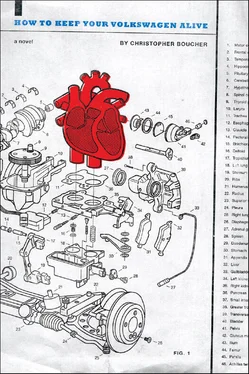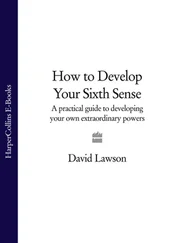What I’m saying is, I conveyed the power’s first chapter as best as I could using the imperfect and dilapidated vehicle of narrative.
As soon as I’d finished, though, I realized I’d made a mistake. I read the VW’s face: It was too much, too soon. He was only a few months old! His engine was racing and his eyes were flickering. When he finally spoke, he did so with a quiet intensity. “How long ago did this happen?”
I had to think about it — sometimes money slipped through my ears. “Two months ago,” I said.
“And I was born right afterwards?”
I nodded. “Just a few days.”
The VW looked out the window. “You must miss him.”
“I do,” I said.
“Does it make you cry?”
“The missing? When I can’t meet it, sure,” I said.
The VW didn’t say anything — neither of us did. We just sat there in the empty lot, watching the face assemble itself.
• • •
The silence was everest. Then the VW said, “Where is he right now?”
“Who?”
“Your Dad. Is he with the Tree?”
“I told you,” I said, sanding down the edges of my words. “Before the Tree stole the farm he — split him in two. He’s dead.”
“He’s dead?”
“The Tree killed him.”
“Wait. That can’t be right,” the VW said.
“No, it is.”
The VW furrowed his brow. Then he said, “But it’s your story.”
“It’s not my story — it’s the only story.”
“But can’t you just change it so—”
“What do you mean, change it?” I said.
“Change it.”
“Look,” I said. “See that face?” I pointed across the parking lot, to the expression-in-the-making.
“Yes,” said the VW.
“This just isn’t Atkin’s Farm anymore,” I said.
“But—”
“It’s a face, whether or not I want it to be.”
“But Dad, wait a second. Think about your options here. If you just try—”
“Try what?” I said. “Try what ?”
“Try feeding me a different story — one that ends well for a change?”
I laughed.
“What’s funny?”
I shook my head. “Nothing.”
“No, what is it?” said the VW.
I turned to face him. “Kiddo,” I said, “these are the only stories I know.”
HOW TO DRIVE A VOLKSWAGEN
CONDITION
Here we go!
TOOLS AND SPARE PARTS
At least two free Sundays
One coil of memorywire
A reading-speed meter
Skip-awareness
A peaceful set of pliers
PROCEDURE
As I’ve said, driving a Beetle is an act of reading:You are seeing a story (the road) and you are responding ( narrative pedal, scene clutch, pagewheel). If you’re doing it right, you are determining your speed, direction and attitude. Your job is to mind the rules of the road (the signs), and to stay clear as to where you are and where you hope to get to.
In some ways, driving the Volkswagen is not so different from driving a VeggieCar. As always, you’re pursuing sound — only moreso in the Beetle. The controls in the VW are mostly the same, too, save for some dashboard gauges and the pedals at your feet. Most modern-day VeggieCars have eight petals, but the Volkswagen has nineteen: six for motion, two for shifting, one for chai, one for connecting, one for marginalia and mountains, two for mothersides and one for letting go. The sequence is not always the same from Volkswagen to Volkswagen, but there should be a chart underneath the dashboard that tells you which pedal is which. And if you lose it or can’t see it, you can either ask your Beetle or make a chart by following each pedal-cable to its source.
The steering controls are pretty self-explanatory, as there are only a few directions to choose from: Turn the page to the right to move forward, to the left to move backwards. Notice, too, the switch for the eyelights to the left.
If you’re used to driving VeggieCars, you might expect your dashboard to tell you about cropping, rot rate, nutrient levels and so forth. But the VW’s dash is different. It’s made from the wood of old trees, first, with needle- and text-gauges carved into the wood.
The standard Volkswagen dashboard layout starts, at the farmost left of the car, with a measurement for Read Speed (R/S)—how fast you’re moving forward. If you go too slow you risk stopping altogether or causing an accident with another driver. Going too fast, though, you risk injury and death. Ten thousand people die each year from driving too fast. I’ve had several accidents, and those experiences have convinced me that we all drive too fast. If we all read as if we were strapped to the front cover of our book, we’d be mindful of other readers and probably save a lot of lives. So I am saying, watch that R/S Gauge carefully.
Next to the R/S Gauge is the WMM—the Western Massachusetts Meter. In essence, this gauge measures friction (right— friction !) — the particular friction of that moment and the half mile or so ahead. How vivid is western Massachusetts at the moment, and what side is it showing you? It could be anything: a vending machine crossing the road; a bathtub opening its mouth and showing you the virus in its throatpipes. And keep in mind that the gauge is not specific — that it will tell you how clear the image is, but not what it is. Nevertheless, it’s very useful on the road. I can’t tell you how many times I’ve seen the gauge hit a red four as we came around a corner, and how glad I was that I hit the breaks when I did.
Gauges Three, Seven, Eight, Thirteen, Fourteen and Nineteen, from left to right, show you the book of power How to Keep Your Volkswagen Alive , the stories within stories, what is dead and what is living and where we are at any given time. Note that each of these gauges lists a separate trajectory. Want to know where we are geographically? Take a look at Gauge Fourteen: It should say “Northampton.” How much do we know about the VW? Check Gauge Seven!
Occasionally, these gauges need to be reset — you’ll know it’s time when they start telling you that you know more or less than you actually do, that you’re in Athens when you’re really in Northampton, that someone is ill when they’re not. Hopefully, convincing the dashboard out and pressing the reset buttons — small memory-coiled flushes — will do the trick. If not, the problem is not the gauge but something else: the cable, the floater, the sensor itself.
Chai levels are reported on Gauges Four and Six. If you get too low, you have no choice but to turn around, wherever you are, and head back to the Haymarket.
Gauge Fivemeasures your relationship to One Side of Your Mother, while Gauge Seventeenmeasures that to the Other Side of Your Mother.
Gauges Nine through Twelvetell you about the various fuels in the car — the stories in front of us and those we’ve already burned, the amount of stories filed away in the front trunk, the approximate mileage each page will get you. Note that these gauges do not measure the layers of skin, stress levels, or bone density of stories — they don’t tell you what we’re holding onto, what we’ve let go of, what we believe and what we can no longer accept, what our hopes are or where (in what town, with which character) our sympathies lie. For that information, refer to Gauges Fifteen and Sixteen.
Gauge Eighteenis the Castaway Meter. This tells you exactly how far in centimeters you are from the Castaway Lounge — the distance between you and those naked, dancing plots. Some models of the Volkswagen Beetle include a compass to direct you back there, but mine does not.
Читать дальше












